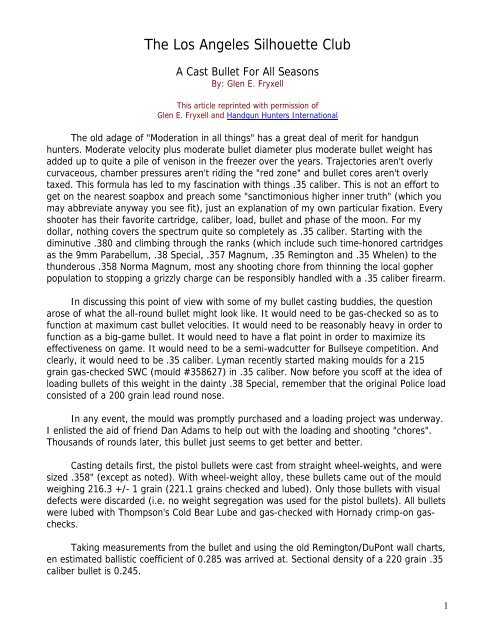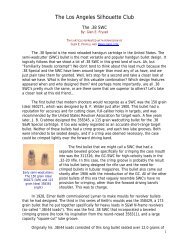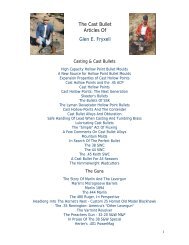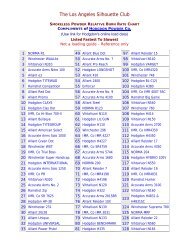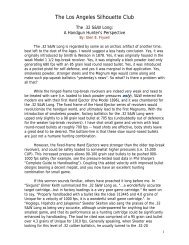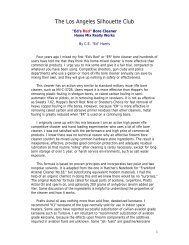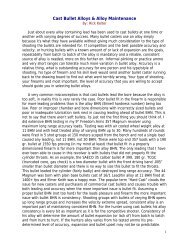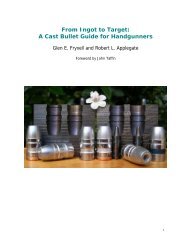Create successful ePaper yourself
Turn your PDF publications into a flip-book with our unique Google optimized e-Paper software.
The Los Angeles Silhouette Club<br />
A <strong>Cast</strong> <strong>Bullet</strong> <strong>For</strong> <strong>All</strong> <strong>Seasons</strong><br />
By: Glen E. Fryxell<br />
This article reprinted with permission of<br />
Glen E. Fryxell and Handgun Hunters International<br />
The old adage of "Moderation in all things" has a great deal of merit for handgun<br />
hunters. Moderate velocity plus moderate bullet diameter plus moderate bullet weight has<br />
added up to quite a pile of venison in the freezer over the years. Trajectories aren't overly<br />
curvaceous, chamber pressures aren't riding the "red zone" and bullet cores aren't overly<br />
taxed. This formula has led to my fascination with things .35 caliber. This is not an effort to<br />
get on the nearest soapbox and preach some "sanctimonious higher inner truth" (which you<br />
may abbreviate anyway you see fit), just an explanation of my own particular fixation. Every<br />
shooter has their favorite cartridge, caliber, load, bullet and phase of the moon. <strong>For</strong> my<br />
dollar, nothing covers the spectrum quite so completely as .35 caliber. Starting with the<br />
diminutive .380 and climbing through the ranks (which include such time-honored cartridges<br />
as the 9mm Parabellum, .38 Special, .357 Magnum, .35 Remington and .35 Whelen) to the<br />
thunderous .358 Norma Magnum, most any shooting chore from thinning the local gopher<br />
population to stopping a grizzly charge can be responsibly handled with a .35 caliber firearm.<br />
In discussing this point of view with some of my bullet casting buddies, the question<br />
arose of what the all-round bullet might look like. It would need to be gas-checked so as to<br />
function at maximum cast bullet velocities. It would need to be reasonably heavy in order to<br />
function as a big-game bullet. It would need to have a flat point in order to maximize its<br />
effectiveness on game. It would need to be a semi-wadcutter for Bullseye competition. And<br />
clearly, it would need to be .35 caliber. Lyman recently started making moulds for a 215<br />
grain gas-checked SWC (mould #358627) in .35 caliber. Now before you scoff at the idea of<br />
loading bullets of this weight in the dainty .38 Special, remember that the original Police load<br />
consisted of a 200 grain lead round nose.<br />
In any event, the mould was promptly purchased and a loading project was underway.<br />
I enlisted the aid of friend Dan Adams to help out with the loading and shooting "chores".<br />
Thousands of rounds later, this bullet just seems to get better and better.<br />
<strong>Cast</strong>ing details first, the pistol bullets were cast from straight wheel-weights, and were<br />
sized .358" (except as noted). With wheel-weight alloy, these bullets came out of the mould<br />
weighing 216.3 +/- 1 grain (221.1 grains checked and lubed). Only those bullets with visual<br />
defects were discarded (i.e. no weight segregation was used for the pistol bullets). <strong>All</strong> bullets<br />
were lubed with Thompson's Cold Bear Lube and gas-checked with Hornady crimp-on gaschecks.<br />
Taking measurements from the bullet and using the old Remington/DuPont wall charts,<br />
en estimated ballistic coefficient of 0.285 was arrived at. Sectional density of a 220 grain .35<br />
caliber bullet is 0.245.<br />
1
The loading was routine, but one comment should be made for the record, and that is<br />
that all cases (both straight-walled and bottle-necked) need to be flared (an RCBS .38/.357<br />
flaring die was used for this data). The short-cut of not flaring cases was tried with the initial<br />
.35 Remington test loads, and my 97 year-old grandmother (grand old lady that she was)<br />
could throw bricks with better accuracy than that ammo was capable of. Flare the cases. <strong>All</strong><br />
loads employed a healthy crimp. This bullet has two crimping grooves. The upper crimp<br />
groove (i.e. the one resulting in the shorter overall cartridge length) was used for the<br />
straight-walled pistol cartridges, whereas the lower crimping groove (resulting in the longer<br />
overall cartridge length) was generally used for the bottlenecked cartridges. In any case (pun<br />
intended, of course), five rounds were loaded at what was deemed a suitable starting point.<br />
The ammo was shot for accuracy and the load increased incrementally until the usual visual<br />
signs said "Stop!". The starting load, the most accurate load and the maximum load were<br />
then fired separately for velocity. These loads were safe in our guns and are presented only<br />
as an accurate record of our findings. As always, start at the low end and work up carefully.<br />
Without any further ado, let's get to the loading data.<br />
.38 Special:<br />
The .38 Special is one of the most loaded cartridges in history. It is a relatively low<br />
pressure cartridge, and the faster burning pistol powders are best suited for this case.<br />
Accuracy of this cartridge is usually quite good, and this bullet was no exception. Five shot<br />
groups at 25 yards were typically under 2 inches, and usually much better, when fired from<br />
an open-sighted, rested revolver. Velocities ran in the 500-700 fps range, as might be<br />
expected for a 6" revolver. It's worth noting that Accurate Arms #2 gave a satisfying<br />
combination of good accuracy and very consistent velocities. A general trend seems to be<br />
that this bullet in .38 Special is most accurate around 625 fps.<br />
Some of you may be asking "What possible use could there be for a 220 grain SWC in<br />
.38 Special?". Windy day loads for outdoor Bullseye competition? Maybe. Custom butchers<br />
typically employ two guns in their trade, a .22 rifle for the routine jobs, and a "big gun"<br />
(traditionally a levergun in .25-20 or .32-20) for the bigger tougher animals. In recent years,<br />
more than one custom butcher has switched over to a Marlin levergun chambered for .357<br />
Magnum and shoots .38 Special loads in it. The .38 Specials aren’t as loud as the .357<br />
Magnums (and therefore scare less of the barnyard stock), and are capable of all the<br />
penetration needed for brain shots. The extra weight of this 220 grain SWC should insure<br />
that the brain is reached in those thick-skinned and thick-skulled critters that are sometimes<br />
encountered in this line of work. Carl Adams is in his 70s and has been a custom butcher<br />
most of his life. He has killed more animals than most hunters will ever see, so he was given<br />
a batch of this ammo (loaded with 3.5 grains of Unique) to “field test”. Carl reported back to<br />
say that both cattle and hogs dropped right now with this load. No staggering, no wobbling;<br />
they simply turned into so much suspended mass for gravity to act upon. Frontal brain shots<br />
typically liquefied the brain (“turned it to mush” were Carl’s exact words), exploded the upper<br />
neck joint of the spine, and then penetrated under the hide of the neck for several inches<br />
(for about 15” of total penetration). Not surprisingly, recovered bullets showed no expansion,<br />
only engraving from the rifling and nose scarring. He also reports that this ammo is<br />
noticeably quieter than the .38 ammo he had been using (undoubtedly because of the light<br />
powder charge).<br />
2
.357 Magnum:<br />
The .357 Magnum was born as the “world’s most powerful handgun” cartridge, which<br />
at the time was probably not the over-used cliché that it is today. It is an extremely versatile<br />
and popular cartridge, both for personal protection and hunting. Whether or not the .357<br />
Magnum is an adequate big-game cartridge is a long-standing argument. This 220 grain SWC<br />
could easily find use in the hunting fields.<br />
Some .357 Magnum brass is thicker than others in the lower portions of the case. Once<br />
this long bullet is loaded into the case, all loaded rounds bulge somewhat and some will not<br />
chamber. Load a dummy round first to make sure your lot of brass will chamber in your gun<br />
once loaded. Federal nickel plated cases were used for the test data. The medium to slow<br />
pistol powders gave the best results. Unique was too fast -- pressures climbed too quickly<br />
while velocities were still low. With powders slower than Unique, accuracy ranged from fair<br />
to excellent, with several 1” groups at 25 yards. Accuracy was generally best in the 1000 fps<br />
ballpark (from a 6” barrel).<br />
From a 6” revolver, 1100 fps was the upper velocity limit for the .357 Magnum.<br />
Accurate Arms #7 proved to be the single most accurate load, putting five shots into<br />
under 1” at 25 yards with 9.0 grain charges, and velocities were quite respectable at over<br />
1000 fps.<br />
Another of the more accurate loads was 10.0 grains of Accurate Arms #9. This load<br />
delivered 875 fps from a 2 1/2” revolver, 959 fps from a 6” and 1012 fps from and 8 3/8”<br />
barrel. Firing this load in a 10” Contender gave 1096 fps. This load was field tested on<br />
Montana jack rabbits over the summer. Launching this load from a 6” S&W 686 consistently<br />
resulted in a solid “Thump!” and a 1/2” to 3/4” exit. Well hit jacks were flattened instantly,<br />
while more poorly hit jacks never traveled more than 20 yards.<br />
<strong>Bullet</strong>s don’t need to be crimped in the Contender, so some test loads were assembled<br />
seating the bullets out to where they just touched the lands (OAL = 1.725”). Working up to<br />
17.5 grains of Acc. Arms 1680, it was possible to achieve 1300 fps. It should be emphasized<br />
that this was possible only in the T/C and that this load is not suitable for .357 Magnum<br />
revolvers. This is a heavily compressed load and it was not possible to increase the load any<br />
further and still maintain the 1.725” overall length.<br />
As a result, recourse was made to a slightly faster burning powder in order to minimize<br />
powder bulk and maximize velocity. When these bullets were launched out of a 10” ironsighted<br />
Contender with 11.5 grains of Accurate Arms #9, accuracy was outstanding (1.0” five<br />
shot groups at 25 yards), and velocities average 1221 fps. The maximum charge of 13.0<br />
grains of AA #9 wasn’t too far behind in the accuracy department at 1.3”, with truly<br />
impressive a (and consistent) velocities averaging 1358 fps. Working up in similar fashion<br />
with W296 revealed a maximum charge of 13.0 grains and a velocity of over 1400 fps! Again,<br />
these loads are for the Contender only, with the 358627 seated to an OAL of 1.725”.<br />
These results should qualify the .35 Magnum as an adequate deer load out to about 75<br />
yards in a suitably loaded Contender. There are some good ol’ boys down Georgia way that I<br />
3
met when I lived down there that like to hunt feral hogs with .357 revolvers, and dollars to<br />
donuts says they’ll be real interested in this bullet. This combination in the Contender could<br />
prove popular in silhouette circles as well. Time will tell.<br />
.357 Maximum:<br />
The .357 Maximum was created in order to convince any stubborn rams that they really<br />
wanted to fall down. This 220 grain SWC at 1400+ fps should prove to be quite convincing.<br />
In addition, this combination could prove to be a good handgun hunting load for deer-sized<br />
game, out to perhaps 100 yards. The loads fired in this Dan Wesson revolver were sized<br />
.356”. Accuracy of most of these load were excellent (as seems to be the norm with DW<br />
revolvers), with several shooting into 1” or less at 25 yards. Stick with the slower burning<br />
powders in the .357 Maximum, the medium burners delivered significantly less satisfying<br />
results with this bullet. The overall winner seems to be Winchester 680, both in terms of<br />
accuracy and velocity. Bulging cases were also observed in the .357 Maximum loaded rounds,<br />
however in no cases did these minor bulges keep the rounds from being chambered.<br />
.35 Remington:<br />
The arthritic old .35 Remington has been with us<br />
since 1906 (a very good year for cartridges it seems).<br />
Thank goodness! It may be old and decrepit, but year<br />
after year it proves itself to be one helluva good hunting<br />
load by putting ton after ton of venison into the deep<br />
freeze. With T/C chambering their Contender for this<br />
venerable old-timer there has been a resurgence of<br />
interest in this cartridge in recent years. Never meant as a<br />
long-distance proposition, the .35 Remington will cleanly<br />
Lyman 358627 & Remington 357<br />
Maximum<br />
take deer out to 150 yards, and the 220 SWC fits into this philosophy quite nicely. What’s<br />
more, with the penetration that this cast bullet is capable of, black bear and elk are also fair<br />
game for this combination. Accuracy was generally quite good, with all powders tested<br />
succeeding in shooting 1” 5-shot groups at 50 yards from a 14” Contender with a 5x scope.<br />
The clear winner was 35.0 grains of IMR 4895 producing a 50 yards group consisting of one<br />
ragged hole and averaging over 1800 fps.<br />
Cartridges for the Contender were loaded to OAL of 2.42” (i.e. crimped in the bottom<br />
crimp groove). Assembled in this fashion, the bullet was lightly engraved upon closing the<br />
action. This OAL was found to be too long to chamber in a Marlin 336 .35 Remington, so test<br />
loads assembled for the rifle were crimped in the upper crimp groove (OAL = 2.30”). Loaded<br />
with 33.0 grains of IMR 3031, the rifle printed 2” groups at 50 yards (open buckhorn sights),<br />
with velocities just over 1900 fps. This OAL length was found to be too short to allow smooth<br />
functioning of the action is the magazine was loaded (the carrier would hang up on the next<br />
round in line), thereby limiting this load to double loading (i.e. one in the chamber, one in<br />
the magazine), which worked very nicely.<br />
.35 Whelen:<br />
The .35 Whelen is a grand old cartridge, with a well-earned reputation as a serious<br />
4
hunter’s load. This Lyman 220 grain SWC could be hard-pressed to find a better home than a<br />
.35 Whelen case. Early tests utilizing bullets cast with straight wheel-weights revealed that<br />
velocities in excess of 1900 fps resulted in key-holing and abysmally large groups (when<br />
lubed using commercial hard lube), thereby revealing after the fact that the .35 Remington<br />
loads were pushing the wheel-weight bullets to their limits. As a result, recourse was made<br />
to a harder alloy consisting of 7 parts stereotype and 2 parts wheel-weights (this alloy is<br />
approximately as hard as linotype). These bullets could be pushed up to about 2000 fps with<br />
very good accuracy. A general trend was noted in the rifle testing -- groups would shrink as<br />
the load was increased until the 2000 fps mark was reached, beyond which group size grew<br />
quickly. As a result, the loads listed are the starting load and the most accurate load for a<br />
given powder. Surprisingly, IMR 3031, traditionally a favorite in the .35 Whelen, provided<br />
very inconsistent velocities with this bullet. Much more consistent velocities (and better<br />
accuracy) was obtained with slower powders. The most accurate loads shot right at, or just<br />
below, 2 MOA (using a 4x scope). The clear-cut winner was 43.0 grains of IMR 4895, giving<br />
an excellent combination of velocity and accuracy.<br />
These bullets were also employed in putting together “grouse loads”. <strong>For</strong> this purpose,<br />
6.0 grains of Unique is hard to beat as it is quiet, very accurate and shoots to the point of<br />
aim at 25 yards (when sighted in with full hunting loads). <strong>For</strong> those who want a little more<br />
punch for their small game loads, 20 grains of IMR 4198 is also a good choice. Both loads are<br />
accurate and generate little noise and recoil.<br />
This may not be the ideal cast bullet for all applications, but it will comfortably handle<br />
grouse, ground squirrels, mule deer and moose, just depending on how it’s served. I’d say<br />
that qualifies it as a candidate for all-round cast bullet. It serves well for paper-punching,<br />
silhouette tumbling and for slaughter around the farm. It’s there for springtime plinking,<br />
summertime varmint shooting fall meat gathering and winter hide hunting. Truly, a cast<br />
bullet for all seasons.<br />
- Glen E. Fryxell<br />
Load Data Begins on Following Page (Pg 6)<br />
Warning: <strong>All</strong> technical data mentioned, especially handloading and bullet casting, reflect the limited<br />
experience of individuals using specific tools, products, equipment and components under specific<br />
conditions and circumstances not necessarily reported in the article or on this web site and over<br />
which The Los Angeles Silhouette Club (LASC), this web site or the author has no control. The above<br />
has no control over the condition of your firearms or your methods, components, tools, techniques or<br />
circumstances and disclaims all and any responsibility for any person using any data mentioned.<br />
Always consult recognized reloading manuals.<br />
The LASC Front Page Index to all LASC Articles<br />
Glen E. Fryxell Article Index<br />
5
Load Data From Article<br />
Test Gun: 6” Taurus 66 .38 Special Test Gun: 6” Taurus 66 .357 Magnum<br />
Cases: Winchester Lyman 358627 Cases: Federal (nickel) Lyman 358627<br />
Primers: CCI 500 Primers: CCI 500<br />
Powder Charge Velocity Comments Powder Charge Velocity Comments<br />
Bullseye 2.0 546 2400 8.0 807 Accurate<br />
2.5 629 Accurate 10.5 1084<br />
3.0 720 Accurate Arms #7 6.5 750<br />
Accurate Arms #2 2.5 546 9.0 1011 Very accurate<br />
3.0 629 Very accurate 9.5 1088<br />
3.5 704 Accurate Accurate Arms #9 7.5 767<br />
<strong>All</strong> #9 loads shot<br />
well<br />
Unique 2.5 516 10.0 959 Very accurate<br />
3.5 708 Good accuracy 10.5 1068<br />
Winchester 540 4.5 607 Accurate Winchester 296 8.5 748 Poor<br />
5.0 718 11.5 1008 Accurate<br />
10.5 959 Very accurate<br />
13.0 1113 Fastest .357 load<br />
Accurate Arms<br />
#1680<br />
12.5 857 Accurate<br />
13.5 914<br />
Accurate, 1096 fps in<br />
15.5 1028 8 3/8”, 1154 fps in<br />
10” T/C<br />
- - - - - - - - - - - - - - - - - -<br />
Test Gun: 8” Dan Wesson .357 Maximum Test Gun: 14” Contender .35 Remington<br />
Cases: IHMSA Lyman 358627 Cases: IHMSA Lyman 358627<br />
Primers: CCI Small Rifle Magnum Primers: CCI 200<br />
Powder ChargeVelocity Comments Powder Charge Velocity Comments<br />
Accurate Arms #7 9.0 961<br />
<strong>All</strong> #7 loads shot<br />
well<br />
H322 31.0 1710<br />
12.0 1231 Accurate 32.0 1834 Accurate<br />
13.0 1307 Very accurate 33.5 1887 Consistent velocities<br />
Winchester 296 18.0 1318 IMR 3031 31.0 1593<br />
19.0 1357 Good velocity 33.0 1785 Accurate<br />
Winchester 680 19.5 1328 35.0 1882 Compressed<br />
20.5 1409 Fast and accurate<br />
Accurate Arms<br />
#2230<br />
34.5 1593 Fair accuracy<br />
IMR 4227 18.5 1280 Accurate 36.0 1927 Fastest .35 Rem load<br />
19.5 1341 Accurate IMR 4895 34.0 1755<br />
35.0 1822 Very accurate<br />
36.5 1871 Compressed<br />
H 335 31.0 1572<br />
33.0 1713 Accurate<br />
37.0 1836<br />
6
Test Gun: Remington 700 Classic .35 Whelen<br />
Cases: R-P Lyman 358627<br />
Primers: Winchester Large Rifle<br />
Reduced loads<br />
Powder Charge Velocity Comments<br />
Unique 6.0 862<br />
Very accurate, on at 25<br />
yards<br />
IMR 4198 20.0 1349 Accurate, on at 50 yards<br />
Full power loads<br />
Powder Charge Velocity Comments<br />
IMR 3031 38.0 1851 Erratic velocities<br />
40.0 1971 Reasonable<br />
IMR 4895 40.0 1845<br />
43.0 1972 Very accurate<br />
IMR 4064 40.0 1802<br />
42.0 1916 Accurate<br />
Accurate Arms #2520 41.0 1946 Very accurate<br />
7


